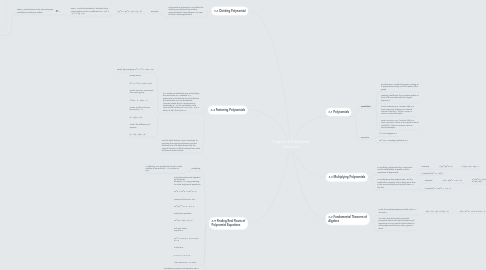
1. 3-3 Dividing Polynomial
1.1. Polynomial long division is a method for dividing a polynomial by another polynomialsof a lower degree. It is very similar to dividingnumbers.
1.1.1. Example
1.1.1.1. (–y^2 + 2y^3 + 25) ÷ (y – 3)
1.1.1.1.1. Step 1 Write the dividend in standard form, includingterms with a coefficient of 0. 2y^3 – y^2 + 0y + 25
2. 3-4 Factoring Polynomials
2.1. If a number is divided by any of its factors, the remainder is 0. Likewise, if a polynomial is divided by any of its factors, the remainder is 0.The Remainder Theorem states that if a polynomial is divided by (x – a), the remainder is the value of the function at a. So, if (x – a) is a factor of P(x), then P(a) = 0.
2.1.1. Factor by Grouping: x^3 – x^2 – 25x + 25.
2.1.2. Group terms. (x^3 – x^2) + (–25x + 25) Factor common monomials from each group. x^2(x – 1) – 25(x – 1) Factor out the common binomial (x – 1). (x – 1)(x2 – 25) Factor the difference of squares. (x – 1)(x – 5)(x + 5)
2.2. Use the table feature of your calculator to compare the original expression and the factored form.The table shows that the original function and the factored form have the same function values.
3. 3-5 Finding Real Roots of Polynomial Equations
3.1. Vocabulary
3.1.1. Multiplicity- The multiplicity of root r is the number of times that x – r is a factor of P(x).-
3.2. Solve the polynomial equation by factoring. Example 1A: Using Factoring to Solve Polynomial Equations 4x^6 + 4x^5 – 24x^4 = 0 Factor out the GCF, 4x4. 4x^4(x^^2 + x – 6) = 0 Factor the quadratic. 4x^4(x + 3)(x – 2) = 0 Set each factor equal to 0. 4x^4 = 0 or (x + 3) = 0 or (x – 2) = 0 Solve for x. x = 0, x = –3, x = 2 The roots are 0, –3, and 2.
3.3. Sometimes a polynomial equation has a factor that appears more than once. This creates a multiple root. In 3x^5 + 18x^4+27x^3 = 0 has two multiple roots, 0 and –3. For example, the root 0 is a factor three times because 3x^3 = 0.
4. 3-1 Polynomials
4.1. Vocabulary
4.1.1. End Behavior- is what the graph is doing as it approaches infinity, or at the ends of the graph.
4.1.2. Leading Coefficient- the numbers written in front of the variable with the largest exponent.
4.1.3. Local Maximum-For function f,f(a) is a local maximum if there is an interval around a that f(x) < f(a) for a every x value in interval except a.
4.1.4. Local Minimum- For function f,f(a) is a local minimum if there is an interval around a that f(x) > f(a) for a every x value in interval except a.
4.2. Examples
4.2.1. x^3 The degree is 3
4.2.2. 2x^2+x-1 Leading coeficient is 2
5. 3-2 Multiplying Polynomials
5.1. To multiply a polynomial by a monomial, use the Distributive Property and the Properties of Exponents.
5.1.1. Example
5.1.1.1. 1.)4y^2(y^2+3)
5.1.1.1.1. 2.)4y2 ∙ y2 + 4y2 ∙ 3
5.1.2. (Answer)3.)4y^4 + 12y^2
5.2. To multiply any two polynomials, use the Distributive Property and multiply each term in the second polynomial by each term in the first.
5.2.1. Example
5.2.1.1. 1.)(a – 3)(a^2 – 5a + 2)
5.2.1.1.1. 2.)a(a^2) + a(–5a) + a(2) – 3(a^2) – 3(–5a) –3(2)
5.2.2. (Answer)a^3 – 8a^2 + 17a – 6
6. 3-6 Fundamental Theorem of Algebra
6.1. Write the simplest polynomial with roots –1, 2/3,and 4.
6.1.1. P(x) = (x + 1)(x –2/3 )(x – 4)
6.1.1.1. P(x) = (x^2+ 1/3x –2/3 )(x – 4)
6.1.1.1.1. P(x) = x^3 – 11/3x^2 – 2x +8/3
